My Corner Online
Boyer Info | Old Mines 2017 | The Story of Céladon | Old Mines 2018
THIS IS MY WORKING GENEALOGY BIOGRAPHIES, PLEASE DO NOT COPY AS FACT. Some photos are personal and should not be copied and republished; other images are okay. Documentation I collected as proof to support facts (i.e. dates, relationships, etc.) are available for your use. I share freely, but please do not abuse copyright or perpetuate any information without supporting facts that may or may not be in error. I try to mark in red my questions or documents I need to look for, so your assistance in making this a complete collection is always appreciated.
Sisters Eleonore and Rosine: Mary Eleonore Boyer and Richard Marshall | Rosine Elizabeth Boyer and George W. Rutledge, Sr.
(Richard Marshall additional pages: Pardon Papers and Supreme Court and My Synopsis and Thoughts and Legends of Richard Marshall)
Videos and Photos in Historic Ste. Genevieve
Eleonore and Rosine's parents: Jean Baptiste Boyer & Maria Aurore St. Germain | Charles Boyer & Marie Madeleine Maurice dit Chatillon | Nicolas Boyer III & Dorothee Olivier | Nicolas Boyer II & Louise Payet dit St. Amour | Nicolas Boyer I & Marguerite Maclin | Etienne Boyer & Perinna Peineau |
Joseph St. Germain and Marie Josephine Josette Calvét (Parents of Maria Aurore St. Germain)
Joseph Antoine Calvet and Marie Josephe Therese Marechal (Parents of Marie Josephine Josette Calvét) | Nicolas Marechal and Marie Jean Illeret (Parents of Marie Joseph Therese Marechal and Antoine Marechal, siblings) | line continues with Antoine below
Jean Baptiste Maurice dit Chatillon & Marie Jeanne Corset (parents of Marie Madeline Maurice dit Chatillon) |
Francois Corset Dit Coco and Elisabeth Bienvenu (parents of Marie Jeanne Corset) |
Jean Baptiste Olivier & Marie Marthe Accica (parents of Dorothee Olivier, wife of Nicolas III) |
Pierre Payet dit Saint Amour & Louise Tessier (parents of Louise Payet dit St. Amour, wife of Nicolas II) |
Nicolas Maclin & Suzanne Larose (parents of Marguerite Maclin, wife of Nicolas I) |
Richard Marshall's parents: Benoist Marechal and Mayotte | Antoine Marechal and Mary Catherine Tabeau | Nicolas Marechal and Marie Jean Illeret | Claude Illeret and Simone Marie Martin (Marie Jean Illeret's parents) | also the unknown Mayotte
Joseph Antoine Calvét and Marie Josephe Therese Marechal
Joseph Antoine Theodore Calvét was born March 13 (or 14), 1730 in Montréal, Quebec, Canada (Point-Clair) to Francois Calvé and Marie-Angélique Bigras. He was baptized the same day at Saint-Joachim-de-la-Pointe-Claire. He was one of seven children born to Francois Calvet-dit-Ste-Foy and Marie Angelique Bigras-dit-Fauvel. He was baptized on the day of his birth at Saint-Joachim-de-la-Pointe-Claire, in Quebec, his godparents being Joseph St-Denis and Marie Francoise Bigras. [Need documentation]
Marie Josephe Marechal was born on or before her baptism of September 28, 1745, to Nicolas Marechal and Marie Jeanne Illeret in Cahokia, Illinois. Her parents were one of the founding families of St. Louis Missouri, who moved from Cahokia to St. Louis. Read more about Cahokia Mounds on this page. [Need documentation]
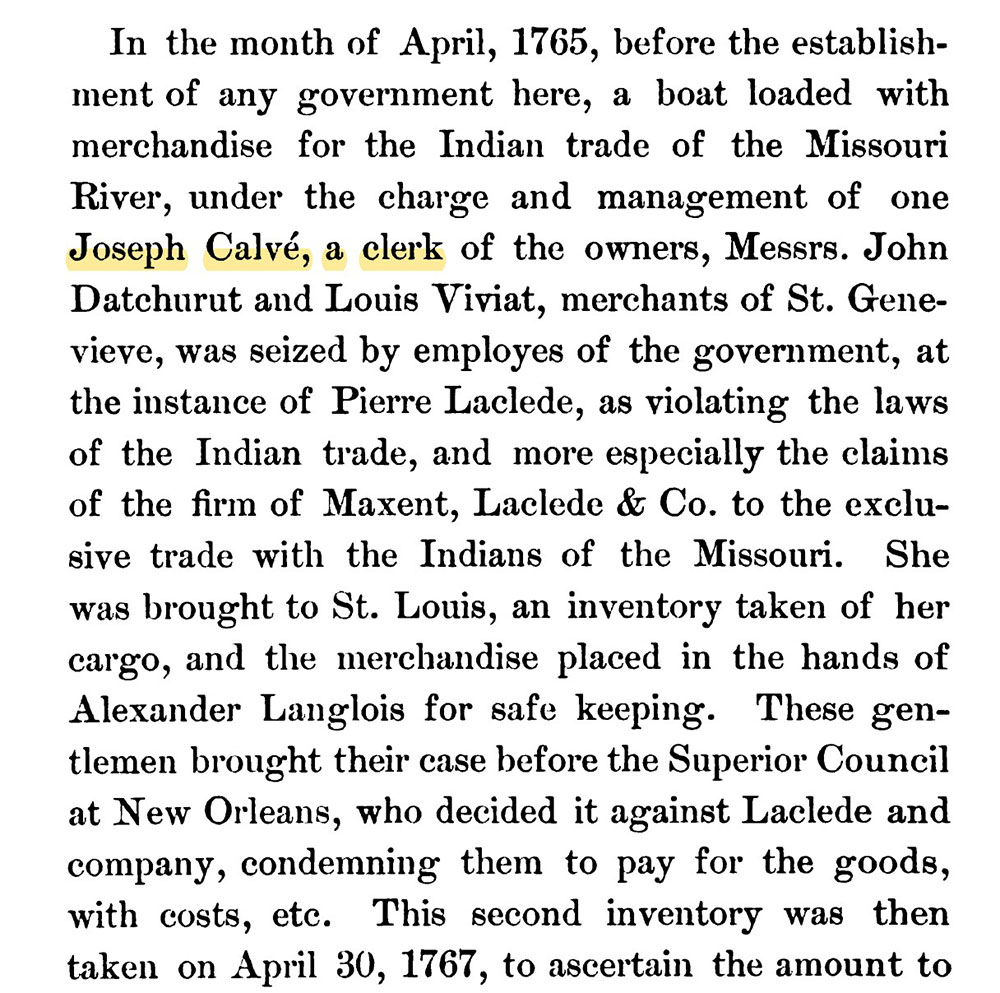
In the Annals of St. Louis (In its Early Days under the French and Spanish Dominations) by Frederic L. Billion, compiled in 1886, Page 50, in April 1765, Joseph Calvé is working as a Clerk for John Datchurut and Louis Viviat, merchants in Ste. Genevieve. Pierre Laclede, of the firm Maxent, Laclede, and Co., questioned the laws of Indian trade with regard to the work that Joseph had done as Clerk claiming his company had exclusive rights for trading with the Indians. Laclede, as "government" siezed the boat of merchandise. This infers that Joseph Calvé was trading with the Indians as well. Laclede lost in a Superior Council of New Orleans case and had to pay for the goods he took.
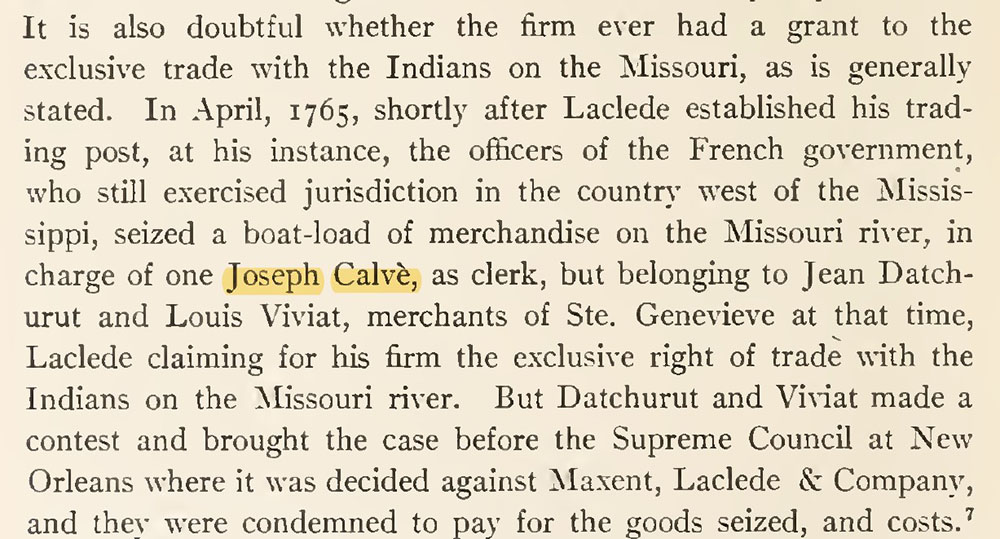
This same story is written in History of Missouri Vol 2 by Louis Houck, Page 2.
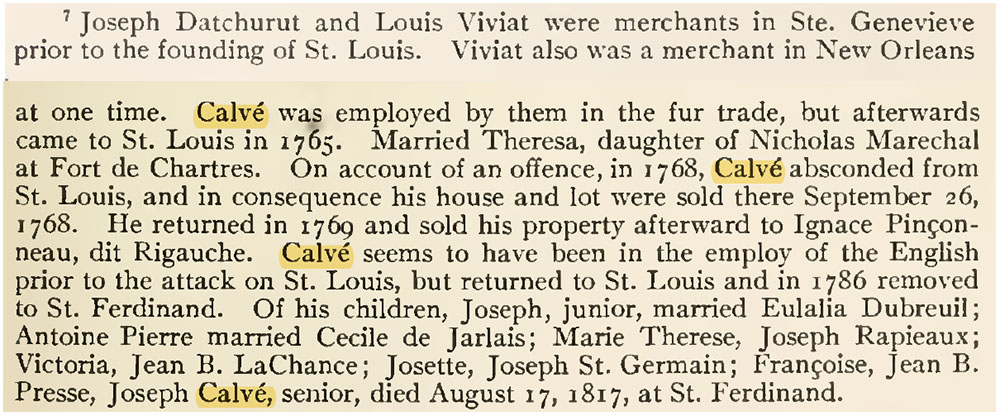
History of Missouri Vol 2 by Louis Houck, Footnote #7.
There is often more information in the footnotes of these old books than the writings themselves! I had wondered if if Joseph was living in Ste. Geneveive at the time on his way from living in Fort de Chartres to living in St. Louis. This tells me that his employer was in Ste. Genevieve so whether he had traveled there from his home in Fort de Chartres or lived there is not known. It was common for folks from Kaskaskia and Fort de Chartres area to traverse the river to the Old Ste. Geneveive. In The Spanish Regime in Missouri as shown below Houck states that he" seems to have lived in Ste. Genevieve."
It is common knowledge that Houck's history contains errors intertwined among truths and we see one here in that he gives Joseph's wife's name as Theresa instead of Marie Josephe. We have confirmation that the couple was married at Fort de Chartres.
There are more parts from Houck's writing placed below chronologically.
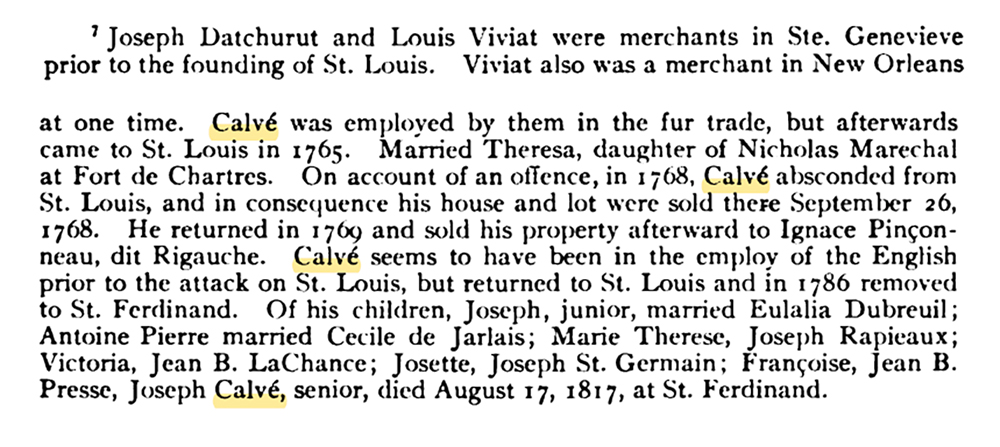
This is the similar accounting from A History of Missouri from the Earliest Exploration until Admission of Union Vol 2 by Louis Houck on Pages 2 and 3, Footnote #7 (1908).
Joseph and Marie were married in 1767(?) at Fort De Chartres. [need documentation]
There is much history of Fort De Chartres. Watch the video and find photos of Fort De Chartres.
About 1765, Joseph and Marie moved to St. Louis, about the same time as her parents. We read this in Houck's accounting above.
In about 1765 Joseph and Marie have a son, Joseph Antoine Theodore Calvét, Jr. born in Illniois (most likely Fort de Chartres where his parents were married). He was killed in an attack by the Indians on St. Louis. He would marry Marie Elisabeth Eulalie Dubreuil. I wonder what happened to his wife or if he had any children. His birth date is from the "The Spanish Regime in Missouri" as shown below in that in the year 1780 he as 17 years old.
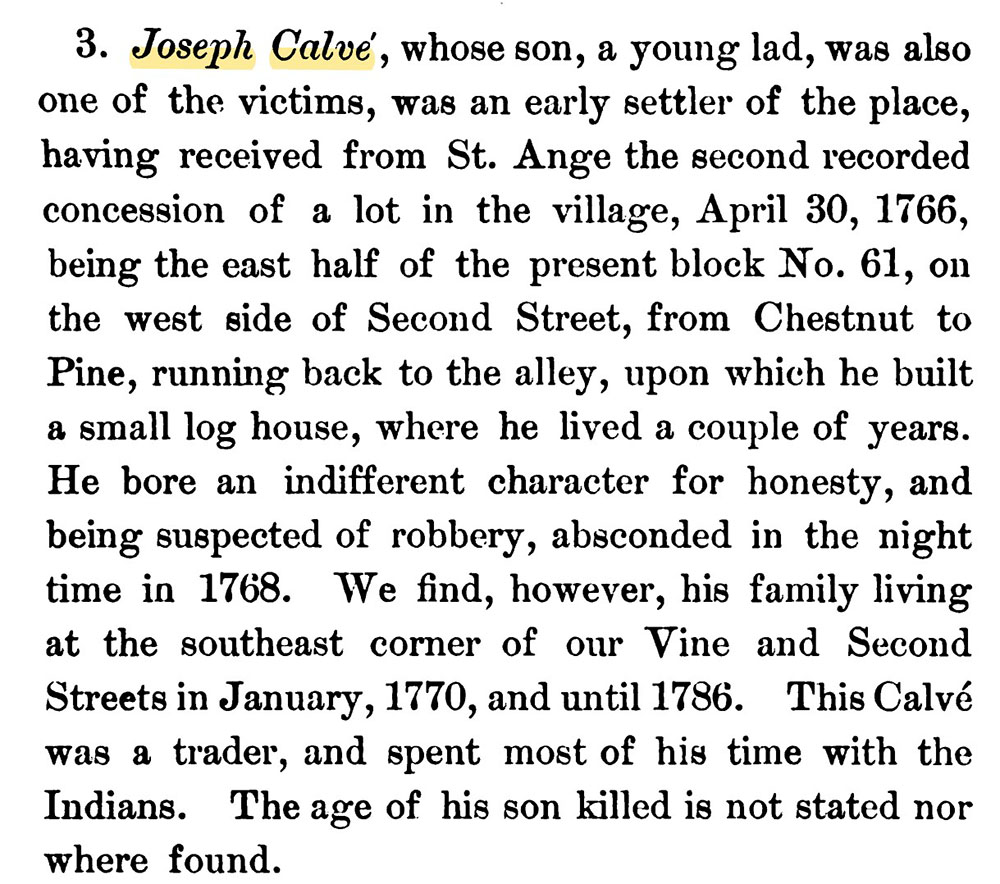
In the Annals of St. Louis (In its Early Days under the French and Spanish Dominations) by Frederic L. Billion, compiled in 1886, Page 119, Joseph Calvé is listed as the third person in "brief sketches of those who were killed on May 26, 1780. This sketch speaks about Joseph Calvé more than it does his son, Joseph Calvé, Jr. We learn about his residences and that he is a trader with the Indians by occupation.

In the Michigan Historical Collection, Volume 20, Page 124, there is a note regarding the Joseph Calvé mentioned in the letter from General Frederick Haldmand to Sir John Johnson dated Quebec 26th May 1783. General Haldiman tells Mr. Johnson regarding communicating with the Michilimackinac, "you would do well to send up Mons Calvé (who is well known as of influence there) with a speech to them . . . " Click here to read the entire letter. The writing indicates that this Joseph Calvé is not our Joseph Calvé from St. Louis and the note indicates that there is a third Calvé who is the nephew of Calvé Sr. and cousin of Calvé Jr. referencing the Mr. Billion's writing, the Annals of St. Louis. We see above that in Billion's writing there is no reference to him being a nephew rather than a son. How odd! The referenced source does not back up this relationship. What this does tell us is that Joseph Calvé had the ability to speak the Indian language and at least communicated with the Michilimackinac tribe. This also tells us that the Indians trusted Joseph Calvé.

In History of Missouri Vol 2 by Louis Houck, Page 65, we see that Joseph Jr was also an interpreter between the English and the Indian. He grew up staying close to his father, Joseph Sr., and learning.
On April 30, 1766, Joseph received a verbal concession from Laclede, on behalf of the Spanish Governer St. Ange, for the East Half of Lot 61, on the west side of Second Street, from Chestnut to Pine, running back to the alley. The couple built a small log house on the property and lived here a couple of years. We read this in the Annals of St. Louis, above. At the same time, Joseph also received a strip of land in the commons for agricultural purposes. The is the first official record of an agricultural land grant in St. Louis, which was two arpents wide and forty deep. (is there a document of land grant? also see Livres Terriens, manuscript copy, Missouri History Muesum Archives for document) Per St. Louis Rising, a book by Eckberg and Person, Joseph's residence is linked through his wife, Marie Marechal, to her widowed mother's Marie-Jeanne Illeret. What is meant by this exactly and where is the documentation?
The July 27, 1766 Militia roll of St. Louis lists Joseph Calvé. This is per the book St. Louis Rising by Ekberg and Person, but I need to find the original document.
In 1766, Joseph and Marie had a daughter, Marie Therese Calvé in St. Louis. She would marry Joseph Rapieux-dit-LaMaire (Joseph Rapieaux) and have children. She would die December 8, 1828 in Florissant, Missouri.
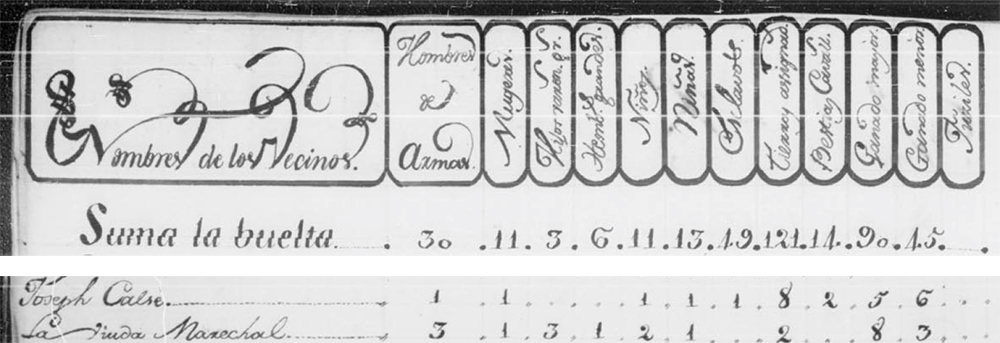
In the May 31, 1766 St. Louis (Spanish Louisiana Territory) census, Joseph Calvé is listed as an arms-bearing man, with a wife (Marie Marechal), one son (Joseph Jr.), 1 daughter (Marie Therese), and 1 slave. This census is available on the Missouri Secretary of State Archives and "are are the property of the National Archives of Spain and cannot be used for any purpose other than research." The family is listed next to Widow Marechal, Marie Jeanne Illeret (ALSO my ancestor), who is Marie Marechal Calvé's mother. In this family are three arms-bearing men (Jacque Marechal, Nicolas Marchal, and Antoine Marechal) (ALSO my ancestor as I have two lines each leading to a sibling), wife (Marie Jeanne), 3 adults males, 1 adult female (Catherine Marechal), 2 sons (Joseph Marechal and Francois Marechal), and 1 daughter (Marie Elisabeth Marechal).
Name of the Residents (Head of Household) is Nombres de los Vecinos; Men of Arms is Hombres de Armas; Women is Mujeres; Teenage Boys is Hijos varones grandes; Teenage Girls is Hembras grandes; Male children is Ninos; Female children is Ninas; Slaves is Esclavos; Assigned lands is Tierras Assignas; Horses and Mules is Bestias Cavalt; Large livestock is Ganado mayors; Lesser livestock is Ganado menos; and Muskets is Fuziles.
From Houck's writing above, in 1768, Joseph was in St. Louis. He had been accused of an offence. Absconded means "leave hurriedly and secretly, typically to avoid detection of or arrest for an unlawful action such as theft." Where did he go with a wife and children for a whole year?! Because of his absence and presumeably the offence of robbery, his house and lot in St. Louis was sold on September 26, 1768. The parcel of land was 240 pieds wide and 150 pieds deep. Grants of land often contained a homesteading provision in which the grantee was required to occupy and improve the land within one year an one day from the date of the grant before title ownership was cleared. This homesteading provision had been commonly in existence since the 1720's in both Illinois and Ste. Genevieve. King Louis XV's 1743 declaration continained a repossession clause. Joseph only improved one of the lots. Although Joseph's conveyance did not specifically set forth the homesteading provision, St. Ange reposssessed the second lot back into royal domain and then granted to Jean Baptist Valeau. In the second grant there is a description that the land is facing the street leading to the chapel. (is there a document?)
Joseph returned in 1769 and sold his remaining lot to Ignace Pinconneau dit Rigauche.
From 1770 - 1776, Joseph Calvé and his family lived at the southeast corner of Vine and Second Street in St. Louis, Missouri, per the Annals of St. Louis by Billions as seen above.
In 1772, Joseph and Marie had a daughter, Marie Victoire Calvét. She would first marry Jean Baptiste Lachasse dit Gourdon (Jean B. LaChance) and later marry Marion Bonaventure-dit-LaBonne and had children by both spouses. She would die July 7, 1818, in Florissant, Missouri.
On March 3, 1774, Joseph and Marie had a daughter, Marie (Josephe) Josette Calvét. She would marry Joseph Gazelle St. Germain. THIS IS MY ANCESTOR, and her biography contains more information.
On October 13, 1776, Joseph and Marie had a daughter, Marie Jeanne Calvét. (Need baptism record) No immediate information is available for her.
On October 30, 1778, Joseph and Marie had a daughter, Marie Angelique Calvét. I do not have any death information for her, only baptism.
On May 25, 1780, the Battle of St. Louis occurred in which Joseph Calvé Jr. was killed by Indians as noted above. This battle was the most western fight in the Revolutionary War and I have written more about it on the Revolutionary War page on this website. Houck indicates that the date of the battle is May 26, 1780, because Joseph Jr. and others have their death recorded in the Catholic Church burial records. (find the burial record)

From History of Missouri Vol 2 by Louis Houck, Page 39.
Joseph was a leader of the Sacks and Outagamies as he undermined the assault by falling back early to protect the citizens of St. Louis. He betrayed his people in favor of the British. From Houck's writing above, Joseph seemed to have been employed by the English (British) prior to the attack on St. Louis. Joseph is the one credited in convincing the Sauk Fox tribe in sending warriors for the attack on St. Louis. Joseph thereafter told the Sauk Fox tribe that he was suspicious because they were between to fires (battle of St. Louis and battle of Cahokia). The forces in St. Louis were victorious. Although he seemed to betray his French people, I would rather believe that he used his ability to communicate with the Indians to manipulate the Indians (and outsmart the British) into falling back early in order to save his people. I see him as more of a hero than a villian. His family most likely was there in St. Louis hiding out in the government building with the other French inhabitants. It would make sense that he would protect his own family and friends. Also it would seem that he returned home to his family after the battle and if he had been a traitor the others would have not let him return. Things are not always as they "seem." The Spanish flag was taken to the fort at St. Joseph, Michigan.
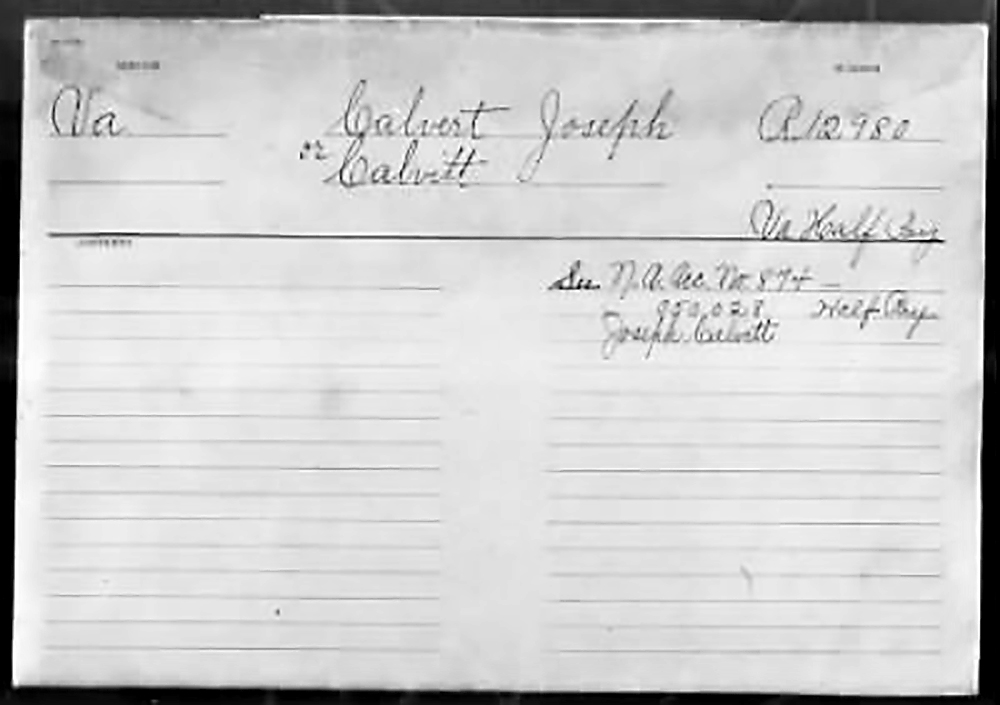
From Find-a-Grave: In May of 1780, he organized a division of Fox and Sauk in an attack on Fort San Carlos in St. Louis on behalf of the English. Later, he succeeded in justifying his conduct and was reinstated by the government after joining Clark’s Virginian regiment as a lieutenant in the American army. At the conclusion of the war, he was sent to notify native tribesmen of the peace agreement between the Americans and the English. [Find documentation regarding Clark's regiment] The above image is from Revolutionary War Pension and Bounty-Land Warrant Application Files on Fold 3. It seems to indicate a Virginia Regiment but I cannot make it all out. It seems to reference another document.
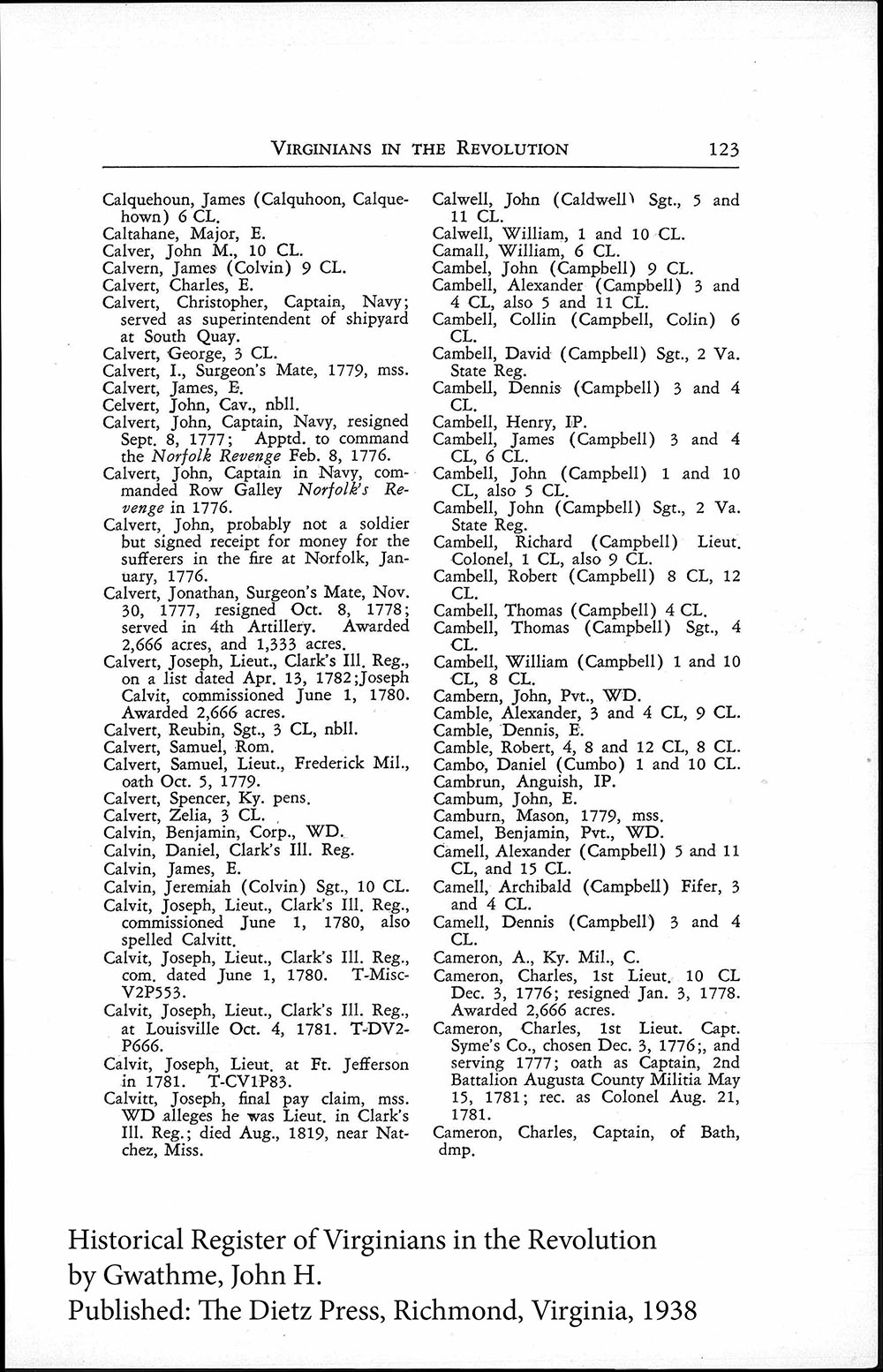
How do they know this is our Joseph Calvet?
On February 12, 1781, the Indians redeemed themselves when they joined St. Louis on a counter attack on the British in Michigan. It was a 600 mile journey during the winter for 60 St. Louis militia volunteers led by Captain Eugene Poure, along with 60 Pottawatomie, Sauk and Fox Indians. They surprised the British and were victorious, bringing the Spanish flag back to St. Louis.
Marie would have been 5 months and 9 days from giving birth to Marie Reine. I can imagine how she endured the battle being 4 months pregnant with her young children as she took cover in the government building which is where the south leg of the arch now stands. There is a possibility that because Joseph knew of the upcoming attack that he moved his family outside of the village. We will never know.
History is that all that were killed in this battle were out in the fields farming outside the confines of fortification, so it would seem that is what Joseph Jr. was doing when he was killed, although I wonder if he was with his father stopping the Indians.
Read Houcks' History of the Battle of St. Louis.
It is my belief that had Joseph not made such a significant move to stop some of the Indians from attacking so that St. Louis was saved, that history would have been a lot different under British governed rule of the territory west of the Mississippi River. I believe Joseph Calvé changed the course of history by his actions. St. Louis remaining under Spanish rule made way for the Louisiana Purchase by America.

From History of Missouri Vol 2 by Louis Houck, Footnote #92
This is the footnote to the above writing regarding his pursuasive comment to stop the Indians from attacking. (Note, find this Wisconsin Historial Collection)
Reading between the lines of these footnotes, I realize that Joseph was questioned thoroughly for his actions in the Battle of St. Louis. Joseph wrote a letter to General Frederick Haldmand on April 23, 1780, approximately one month before the battle occurred.
This indicates that in 1783 Joseph was still serving the British three years after the Battle of St. Louis. Was he really serving them, or still being a covert spy in enemy territory? Those who gather counter intelligence during war are never really there, right? It is so top secret that their presence in enemy territory does not get recorded in history. There are many people who service in this capacity in America that never get credit for their service to our country because of the level of top secret information for safety reasons. It seems logical to me being that his family remained in St. Louis where his true loyalty stood with his French and Indian commrades under Spanish rule. These were the same families who had removed themselves from the east side of the Mississippi because they did not want to be under British rule thereby becoming the first settlers of St. Louis for that very reason.
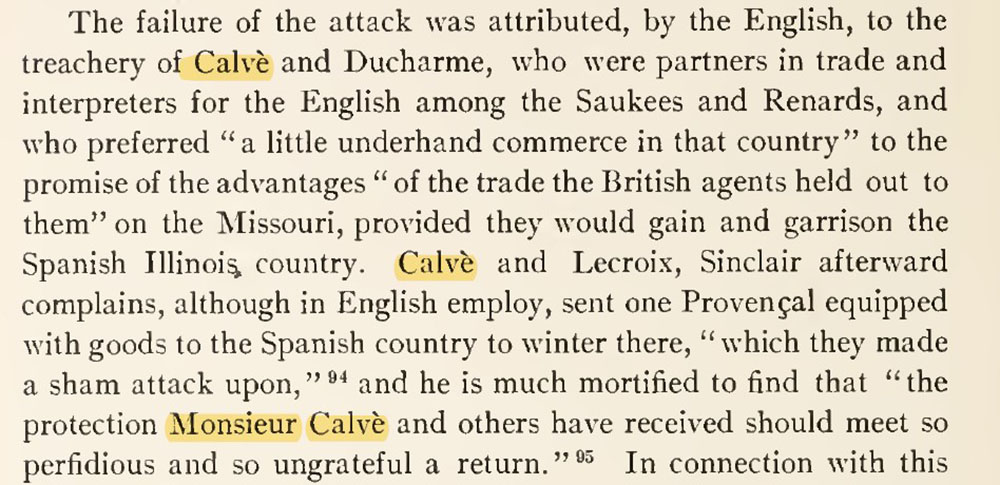
From History of Missouri Vol 2 by Louis Houck, Page 40.
Houck reveals to us what he thinks about Joseph's intentons durings the Battle of St. Louis. Houck again uses the word treachery which means "betrayal of trust; deceptive action or nature." It sounds to me like Joseph knew how to work the merchandising system to his advantage. Entrepeneurs have always done this and continue to do this in the name of making some money. They find the underhanded loopholes and use them to optimize results and those who get played are always jealous of their success. Houck believes Joseph and his partner preferred trading with the Indians over taking the British up on whatever deal they promised.
To understand the next sentence, I found the definition of Provençal to be that of French dialect. I read this sentence as Joseph being employed by the British and sending a French person with goods to St. Louis where they made a sham attack upon. The Battle of St. Louis was not what it was purported to be because of Joseph's protection over St. Louis. The return that Joseph received for his protection of St. Louis was an ungrateful and perfious one. Perfidious means "deceitful and untrustworthy." If I am reading that correctly, Houck agrees with me that Joseph deserved much thanks for his actions.
The footnote #95 states "Ibid., p. 161" referencing footnote #94 which states "11 Wisconsin Historial Collection, page 158." (Note, find this Wisconsin Historial Collection)
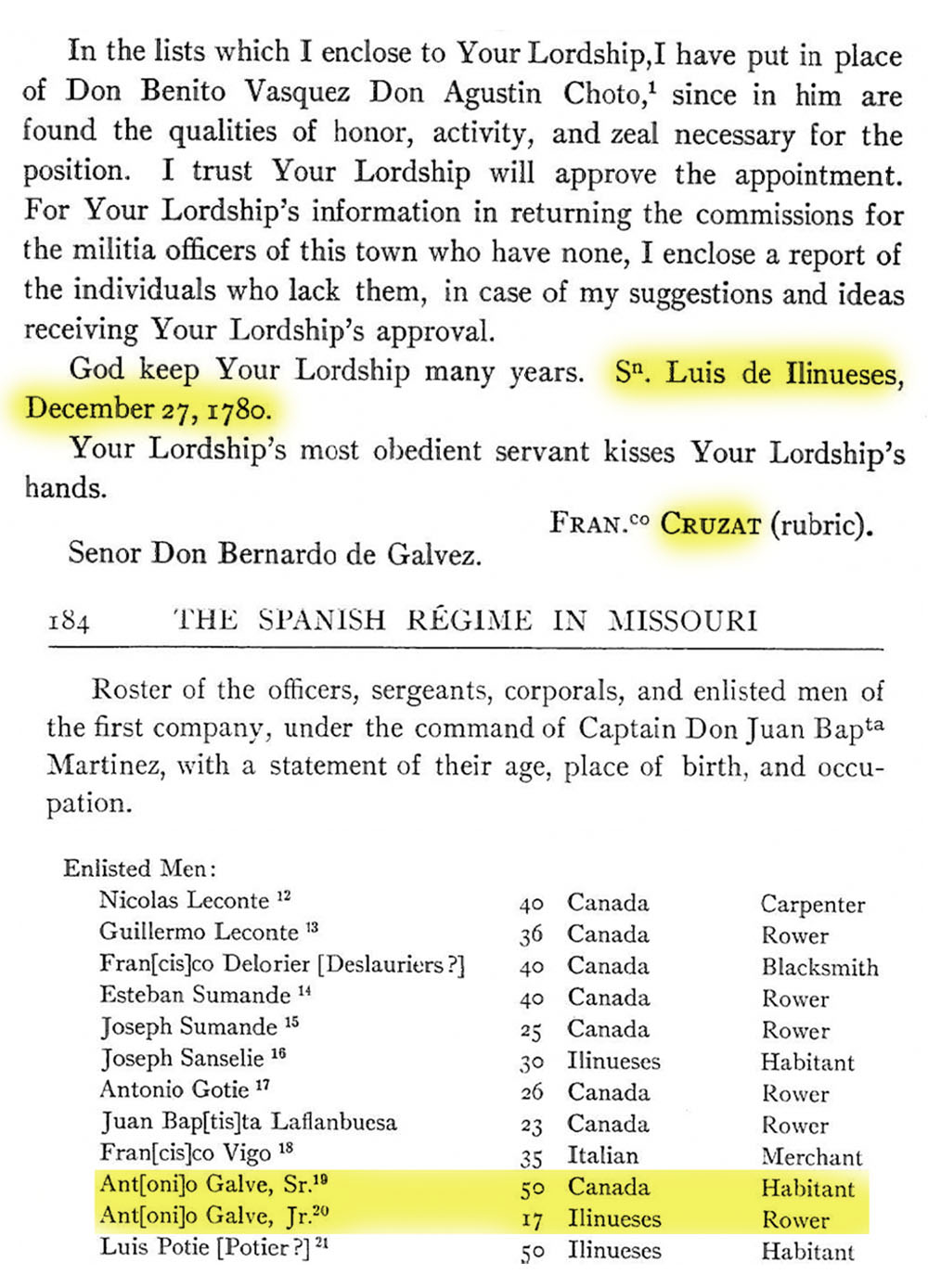
In The Spanish Regime in Missouri, Volume 1 . XL, Page 184, by Louis Houck (originally published prior to 1923), there is a list of the soldiers in the Spanish Regime which include Joseph Sr. and Joseph Jr., giving their ages and 50 and 17. Joseph Sr. is a "Habitant" and Joseph Jr. Is a "Rower." Joseph Sr. is of Canada and Joseph Jr. is of "Ilineuses." I note that the date of this list is in December 1780, after Joseph was killed in May. It was good of Cruzat to include him even after his death. Joseph Sr. is from Canada and Joseph Jr. is from Illniois. My ancestor Antoine Marechal is also listed in this same list of soldiers. Antoine Marechal and Joseph Calvet are brother-in-laws because Joseph Calvet was married to Antoine Marechal's sister, Marie Josephe Marechal.

These are Footnotes #19 and #20 by Houck which indicate that he believes these two names to be Joseph Sr. and Joseph Jr. and repeats the information provided in his other book.
On November 3, 1780, Joseph and Marie had a daughter, Marie Reine Calvét. She would marry Toussaint Tourville and have children. She would die on October 1, 1835 in St. Louis, Missouri.
From Houck's writing above, Joseph returned to St. Louis in 1786 and removed to St. Ferdinand (Florissant), Missouri. A French Catholic village was was named St. Ferdinand de Florissant after St. Ferdinand III, who was King of Castile, Spain from 1217 to 1252.
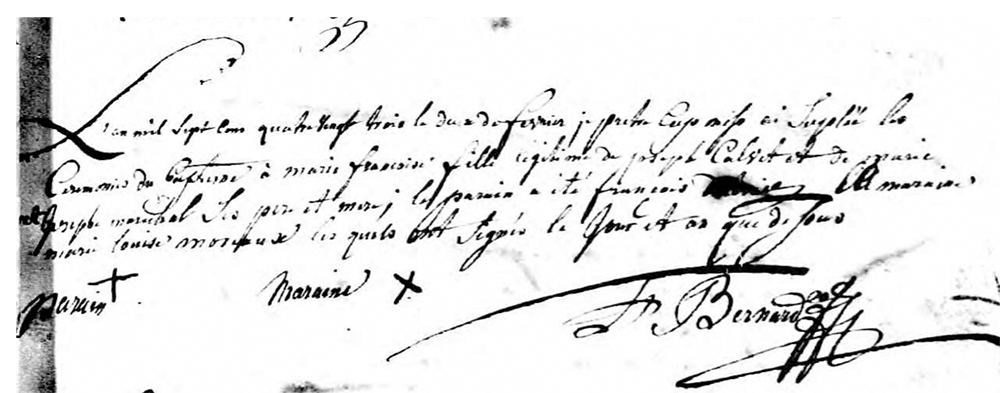
On February 2, 1783, Joseph and Marie had a daughter, Marie Francoise Calvét. She would marry Joseph Baptiste Presse-dit-Girard (Jean B. Presse) and have children. She would die in September 1850, in Florissant, Missouri.
On January 14, 1786, Joseph and Marie FINALLY have a son! Antoine Pierre Calvét does not have much information available about him except genealogist have marked that he died sometimes after 1791. Houck's history indicates that he married Cecile de Jarlais.
Marie Josephe Marechal Calvét died on July 1, 1791. (need documentation)
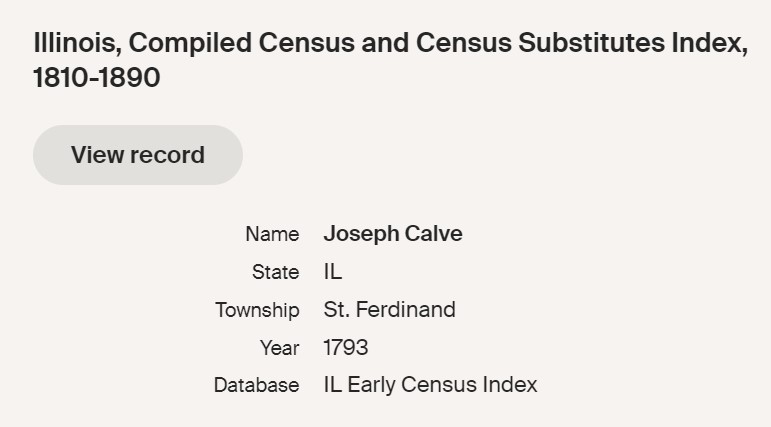
There is a 1793 Illinois Early Census Index that lists Joseph as living in the St. Ferdinand Township of Illinois.
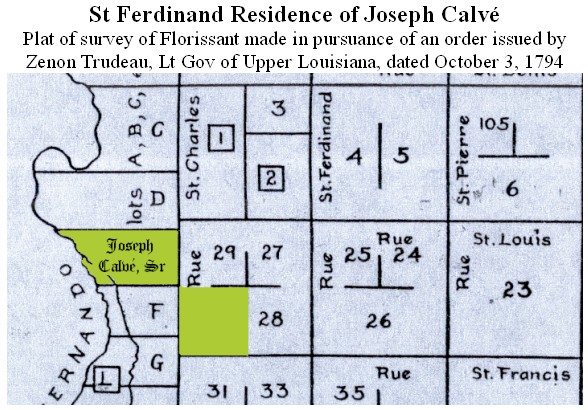
Plat Survey of Florissant, 1794; Joseph Calvé Sr. edited, JPinz (as found on Ancestry)
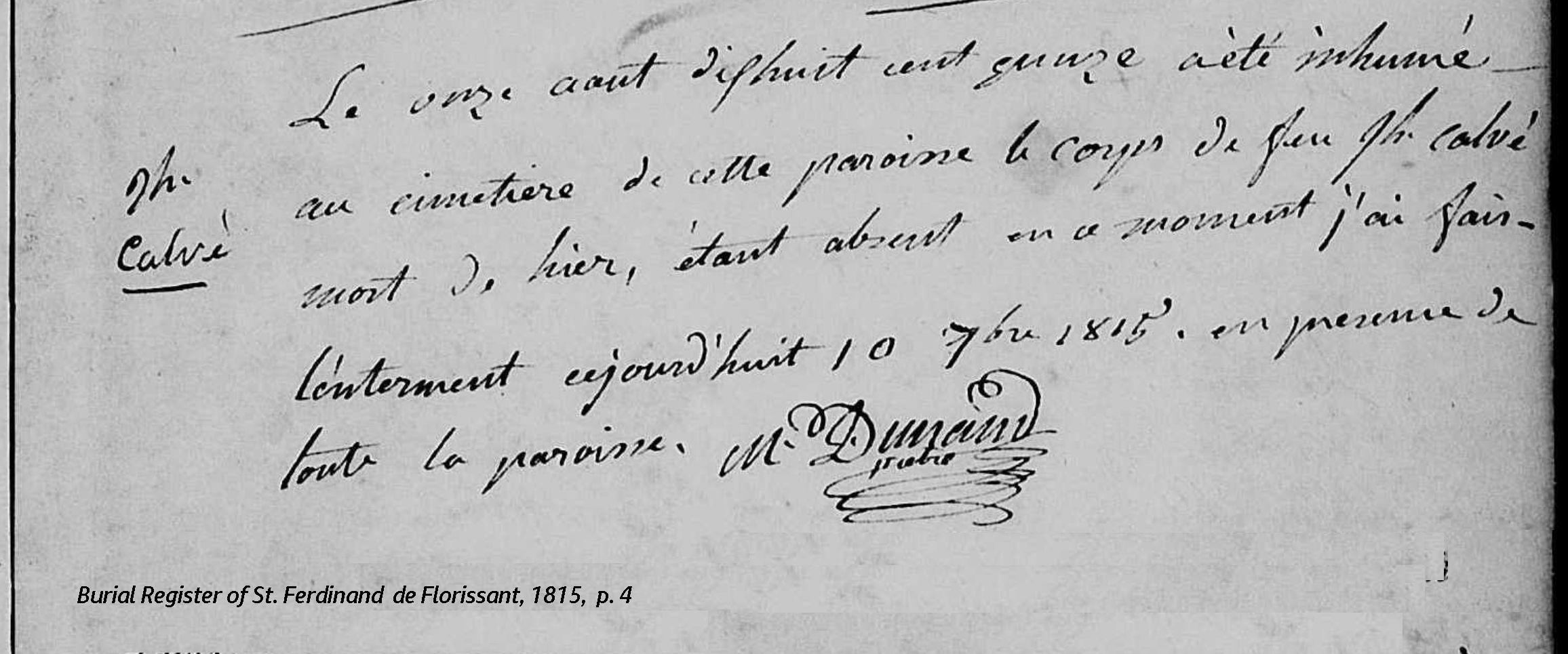
Joseph Calvét died on August 10, 1815, in Florissant, St. Louis County, Missouri (St. Ferdianand, Missouri Territory; St. Ferdinand de Florissant) where he had lived since 1786 for 29 years. Here is is listing on Find-a-Grave and no marker is shown.
From Find-a-Grave, Note the year of 1715 is incorrect: Joseph died on Aug 10, 1715, and was buried on Aug 11, 1715 in the Old Saint Ferdinand Cemetery (Defunct), Florissant, St. Louis County, Missouri.